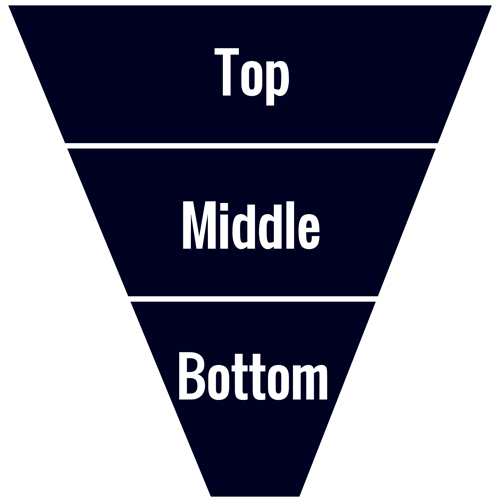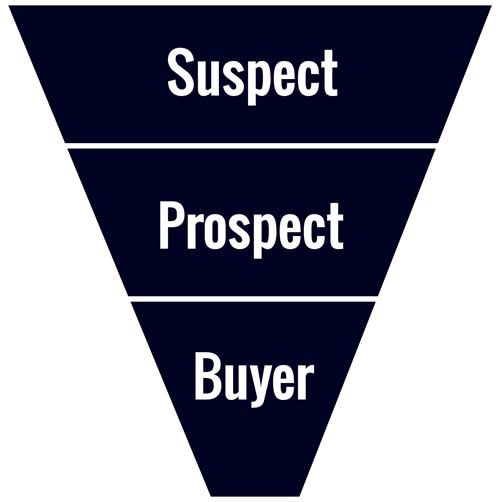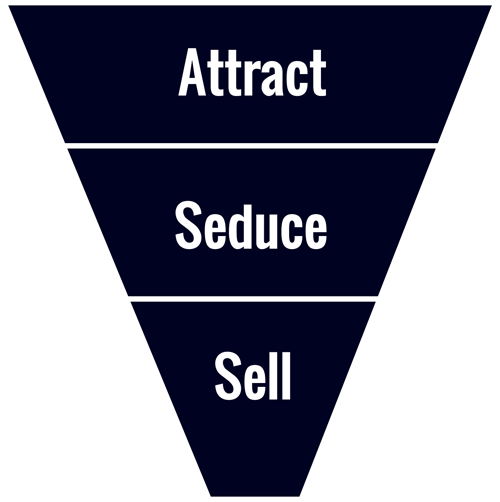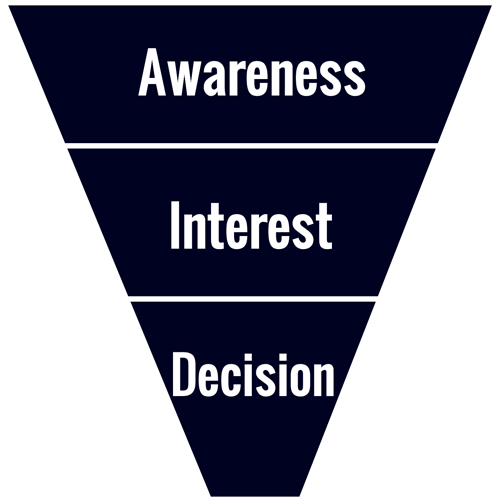Want to attract more leads but avoid time wasters? Want to talk to the right prospects and sell without hassle? You need a marketing funnel.
Video Transcript
Hello, it's Darren from Ilkeston Web Design. I'm here today to talk about the marketing funnel. What the bloody hell is a marketing funnel? Well, I'll tell you...
People go in one end of the funnel and customers come out the bottom. So it looks like that. At the very top, people are aware of your business, but they're not in the market and don't intend to make a purchase, at least not for the time being, and people at the bottom are actually purchasing from you right now, or possibly considering purchasing again, and people in the middle are interested, but they're in the research mode.
They're comparing, they're weighing you up against a competitor.
So top, middle, bottom.
And this applies not just to a website, but to a social media profile or whatever channel you're using to market your business.
So put yourself in the shoes of a buyer for a moment. That's quite easy to do because we are all buyers. And it starts, well, it's with a problem, right? There's a need or a want. There's something that you want to solve, and you're willing to spend money in order to solve that problem.
And you'll think, "well, how much would it cost to solve this problem? Do I need professional advice? Can I do my own research? From whom will I buy this product or service? Do I need to save money in order to afford it? And how long should I spend thinking about this before making a decision?"
What has this got to do with your website as a business owner?
Imagine the website is a funnel then – so wide top, narrow bottom – and each stage of this funnel speaks to and represents whatever point a potential buyer is at in their own buying journey.
So the types of content that you have at the top is written or produced in a different way to the kinds of content that you have at the bottom. So bottom of funnel is more about people who are ready to make a purchase. Whereas top of funnel is for those that aren't even considering it.
And it might just be that you're wanting to get on the radar of the types of people who might eventually want to buy something that you sell.
Ultimately it's about attracting, seducing and selling. Because selling is the most important thing.
Because we need to make money, we need to make a profit, right? So it's all about selling. Everything we do is deliberate and leads towards a sale. But not every stage of the funnel needs to be salesy because that turns people off.
So here's a quick summary. Top, middle, bottom. Awareness, interest, decision. Suspect, prospect, buyer. Attract, seduce, sell.
So what is the definition of marketing? It's a good idea just to take a breather and say, well, there are many ways to define it. And you can go on Wikipedia or whatever and you can read some very convoluted, long-winded article which gives you a definition of marketing.
But, there's a very succinct version which is "marketing is creating and communicating value to a target customer in order to make a profit."
Not everybody enters the funnel at the top. So it's not necessarily a linear process.
I mean, if you've got a bust pipe and you need an emergency plumber, you're ready to make a decision in the next 10 minutes. So you'll go on Google and look up an emergency plumber and give them a call. You don't need to go through this whole, like, awareness and interest thing.
Unless, of course, you're having a kitchen fitted and you're going to need a plumber to come in and help plumb it in. In which case you've got a bit more time to think about that. But people with problems that require immediate solutions can be characterized as being in the bottom of the funnel.
They need it now. They need a solution immediately.
When you create content for your website, tell people what they need to know. Give them the right message at the right time and in the right format.
How much content do you need on a website as part of this funnel? Well, a basic marketing funnel strategy hits all three stages of the buying process. Awareness, interest, decision.
Although, depending on what kind of industry you serve, the sales cycle might be longer, therefore, the funnel might be a little bit more complex. People don't necessarily come in at the top and go out the bottom. Sometimes they start at the then they might see a competitor and they're all over the place.
So do you want to hit all stages of the funnel from the get go? So, let's say we're building the website and we're coming up with content, whether it's text, video or whatever. Do we want to do all stages of the funnel? I'd say no.
No. I'd say focus your effort on the bottom of the funnel to begin with. Talk about what you do for your ideal customers. Talk about features, benefits and outcomes. Get to the point. Think about what format is best. Video tends to go down well with most people in most industries. A short video is pretty palatable to most people. So there's a good tip on the format.
More good content equals, generally, more opportunities to attract, seduce and sell. And it's a little bit experimental because some things won't work and some things will. But you'll never know if you don't try.
I can give you a few ideas if you like. This is a very high level overview, obviously. So let's start with bottom of the funnel.
So these are people that are ready to buy your stuff, like... now. This is where you can talk about yourself and what you do, how your specific solution solves the customer's need. A lot of websites are built like this, ya know, those brochure websites.
Unfortunately, bottom of the funnel is all they ever do. Like they do that and then they stop and, like, they think it's over. But it's actually, you know, it's ongoing.
But it's a good place to start and you should start there. You should do a good job of it. So this kind of bottom of funnel content is characterized by topics along the lines of "how we [fill in the blank]".
So that could be "how we fit boilers", "how we valet your car", "how we sew dresses". This is where you talk about you and how you do it differently and what the process is. This is you selling.
You know, if I was talking about websites, I would have web design, web development, SEO, graphic design, I'd have different pages on different topics and I'd talk about each service that I provide because most services can be broken down into the sum of its parts. So that's why you have like a services page.
And the kind of content you could do would be, well, services pages, but case studies as well, testimonials, sales presentations, webinars, giveaways and coupons – if you're playing the discount price game, if you've actually got a loss leader pricing strategy, then you could be doing giveaways and coupons. But that's the bottom of the funnel. You know, it's about selling. So this is like the meat and potatoes of your business, what you do, the problem that you solve.
That's good. But what else can you do? Well, there's a middle of funnel. So these are people that not necessarily going to buy right now, but they are in the market and they are certainly interested.
They are looking to do business soon. So with this kind of middle of funnel content, you'd be giving advice on things that are on your potential customers' minds. You want to nurture them, right? They're in the consideration stage. They may be comparing you to your competitors.
This kind of content can generally be characterized as it's along the lines of "how to", "how to choose a mortgage broker", "how to decide what kind of window is best for your property", "how to decide what kind of website system is the best for a business of your size". It's that kind of thing.
So it's not salesy. It's where you demonstrate knowledge and expertise, this kind of content is more educational, more informative. You're not having to give away trade secrets. It's not what it's about, but it's being able to demonstrate that you have expertise, competence and wisdom, and it can help to warm up those prospects and move them down towards the bottom of the funnel, right?
So example content could be more in-depth blogs and articles. It could be a guide. It could be an ebook. It could be a report or a white paper, product demo, videos. If you've got a product or service and you need to demonstrate it in a very clear way, you could do that at this stage.
You could do classes or workshops depending on what you do.
I mean, sometimes classes and workshops are like a way of finding really good prospects for like a high ticket service that you sell. You might put on an event for the day and the people that come along, of all those people that come along, some of them might be serious business prospects for you to work with.
And free tools as well. I don't know if you've ever seen some of these financial tech businesses or even accountancy firms, they'll often have like online calculators to help you calculate the cost of a currency conversion or to find out how much tax you could be saving in any given fiscal year.
So you get these online tools that you can use to... it's part of, sort of, warming you up really, but you know, these things are definitely middle of funnel with a view to moving you towards becoming a customer, right? It builds trust.
So the top of the funnel, well, as we've established, these are people that aren't in the market yet, right? So they're suspects, they are an addressable audience, okay? So they are not looking to put their hand in the pocket anytime soon. They might not even know that they've got a problem. Maybe they don't have a problem right now.
So it just could be people in the local community, people who one day might buy something from you, but have no idea you exist, and unless you do some top of funnel content, they might not ever learn of your existence.
So in the top of the funnel, you're talking about things that are relevant to this addressable audience, but without being salesy, because they're not in the market, they're not going to buy anything. This is the awareness stage. And this can be characterized by content along the lines of "what is", where you just talk about things which perhaps they've never heard of, or they're not aware of.
I'll give you an example. Let's say you're a firm of accountants, and there's a particularly insidious scam going around on email or WhatsApp or something like that. You could put on your journalist's hat, and do some kind of expose of the scam, and publicize it far and wide, and just get it into the hands of various people.
Now that is potentially getting people into your funnel, because you're talking... there are business owners out there, right? They don't need an accountant yet, but they certainly don't want to get scammed. So if you're writing content that helps them solve a problem today, without them having to give you any money, and all you've done is write about a particular scam, and what to watch out for, and how it operates, and how much money people have lost. If you can do something like that, you're potentially getting on the radar of people who might, at some point, it could be years down the line, at some point they might need an accountant. And if you've helped them out in some small way, they may remember you and get in touch.
So that's an example of top of funnel content, and there are scams in all industries. So that's always a good one to go for, because people hate being scammed. And if you can help them out, write about it on your website, and do a good job of it as well. Don't do it half-arsed.
So example content then, well it could be shorter blogs and articles, it could be guides, ebooks, reports, and white papers.
Again, it could be podcasts. The format is often interchangeable, but it's often the message and speaking to where people are at.
Just because someone is at the bottom of the funnel, it doesn't mean they won't get value from what's at the top, because although they've already bought something from you, this bit of content that you create could still have value for them.
And the next time they need to buy something similar, they're going to come back to you, or they might refer you to somebody they know. Don't just build a website which is full of rubbish, nonsense content. Think about why you're doing this, and for what purpose, because ultimately, you want an outcome, right?
You want to sell to the right kinds of people at the right price. You don't want to sell to just anybody and everybody. You want to qualify your prospects, and you can do that in a very deliberate way through your content.
What the bloody hell is a marketing funnel? I’ll tell you. People go in the top and customers come out the bottom. Yeah… sounds a little bit abstract, doesn’t it? 🫠
Stay with me.
It all ties in to the mental process buyers go through before making a decision. Generally speaking there are three stages to the marketing funnel.
- 👤 Top
- 👥 Middle
- 🫂 Bottom
Each stage of the funnel represents the average buying journey of someone discovering and eventually purchasing a product/service. Bit like dating.

Basic marketing funnel
What Do You Actually Want Out of Your Business?
Before we go on, let’s establish why you should care and why you should even bother to understand this funnel concept.
The following statements are probably accurate:
- ✅ You want to make a profit
- ✅ You want to be less busy
- ✅ You want to attract the right sorts of business leads
- ✅ You have an ultimate outcome in mind but getting there is tricky
If any of those statements resonate with you, you need to do a better job of marketing and sales instead of being solely focussed on The Thing you sell. ♟️
And just to be clear: marketing is not all about you, your growth plans, your awards and your long list of achievements. Prospects do not care about those things.
So why would someone want to buy from you?
Suspect, Prospect, Buyer 🛗
Businesses solve problems. Typically, when someone buys it’s to solve difficulty or fix pain. 💷
Maybe they ran out of washing up liquid. Maybe the kitchen flooded. Perhaps they’re starving. They may be looking for mortgage or life insurance advice.
It actually doesn’t matter as long as you understand people spend money when they want/need to change something. 🧩
To summarise:
- 👤 Suspect: doesn’t have a problem, won’t buy (yet)
- 👥 Prospect: has a problem, needs a solution, will buy soon
- 🫂 Buyer: has a problem, making a purchase decision right now

Basic marketing funnel
Marketing: Pre-selling to Your Ideal Customer 🎯
Whatever you are or are not doing is attracting the kinds of enquiries you get.
Maybe you’re happy with the situation, but perhaps it all feels a little bit, well… “leaf blowing in the wind” or more accurately – for some businesses – “plastic bag in a tornado”.
How can you avoid or change this? 🧐
Marketing. There’s no debate to be had on whether you should/shouldn’t. No wriggling out of it.
Marketing delivers the right message, to the right person, at the right time, in the right format.
Marketing is creating and communicating value to a target customer for a profit.
Attract, Seduce, Sell 🛗
Remember, suspects, prospects and buyers occupy a certain psychological space.
They might be close to a purchase or a long way off.

Basic marketing funnel
What’s certain is that your marketing content must communicate value to help convince and persuade someone to choose to do business with you instead of someone else.
Here’s what to do for each stage:
- 👤 To Attract: inform, help, educate, entertain, get on radar of suspect
- 👥 To Seduce: inform, help, educate, instruct prospect
- 🫂 To Sell: inform, enable transaction with buyer

Basic marketing funnel
Qualify/Disqualify Prospects with Marketing Content
Let’s face it – if you’re having long phone calls or answering prospect emails in detail (as in the ones that never go anywhere), you’re wasting everyone’s time.
Tyre kickers are better dealt with early on (one way is to have people book phone calls rather than call when they feel like doing so).
And just because someone looks, sounds and smells like a prospect, it doesn’t mean you treat them like royalty or become subservient. 👇
Create content that helps to:
- 🧲 Answer questions and strengthen interest in the minds of those you want to sell to
- 🎲 Filter out and even repel prospects you don’t want to sell to
The purpose of good content is to:
- ⚙️ Nurture the prospect in a way that’s more hands off
- 🧩 Set expectations for the prospect and help them make the correct decision
Mini Action Plan
Focus initially on the bottom and middle of funnel:
- Keep a recorded list of common questions/concerns from prospects/clients
- Identify (with better questions) the real pain points of prospects/clients
- Address questions, objections and bottlenecks using website content
- Give advice, demonstrate expertise and develop trust using website content
Work with someone who can help you with:
- Research and strategy
- Scripting/writing/editing
- Production/publishing/distribution
The finished content can be used for your website but also repurposed for other channels like social media, direct mail etc.
When interacting with customers, make it a priority to send links to relevant bits of content so you don’t spend so much time chit-chatting 🔗
The prospect is not the leader – you are. 🫵
Choose Your Customers 🏁
To have a strategy is to set a goal and do the things needed to achieve that goal. It’s all done deliberately – on purpose.
Keep the following truths in mind:
- ✅ Correct sales happen when there is correct marketing
- ✅ Marketing is communication with a commercial purpose
- ✅ Attracting, seducing and selling to the right prospects is a process
Good marketing funnel content gives you back time to focus on:
- ✅ Doing the actual work
- ✅ Delivering an excellent service
- ✅ Charging a healthy price to turn a profit and keep doing good work
Why repeat yourself over and over by phone, in person and over email?
It’s not strategic. It’s a recipe for disaster. Especially if you try to “grow the business” by prematurely spending loads of money on ads.
Develop a well-oiled marketing machine in order to develop a sales pipeline. Who knows, you might end up being to sell the business one day, but not if it’s a sitting duck.
Oh, and another thing – do not copy your competitors because they’re rarely worth imitating.
Summary: So What Do You Want?
Most businesses have an ultimate desired outcome for themselves, yet many have painted themselves into a corner from which they cannot escape.
Here’s what happens to so many businesses:
- 🎲 Beaten down on price
- 🎲 Always busy
- 🎲 Don’t know if they’re profitable
Here’s what to do instead:
- ✅ Build a website with purpose
- ✅ Attract, seduce and sell
Do Less and Sell More at a Higher Price
If you look/sound/smell like every other business – and if you appear to be selling the exact same thing as what your rivals do – guess what happens?
Prospects find themselves in a situation where they have no choice but to judge you on a lowest common denominator because there’s no way of determining why you’re different.
What do you think that lowest common denominator is, by the way?
Yep. Price. 🙃
Do better marketing to get a better quality client or customer. Charge more and reinvest the money in better delivery of service and even better marketing.
Being busy isn’t your goal – profitably is. 🤝